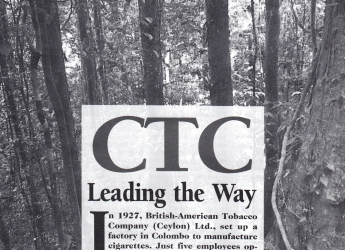Leading your employees means more than how you manage them. It is important to think about leadership in terms of our influence, which involves a group of employees. Our success in moving forward is as much a function of our leadership behaviour, as is taking care of our company.
To achieve this, we must believe in what we’re doing; gain the confidence and commitment of our employees; and act decisively.
I will now outline five elements of leadership which I believe are key differentiators.
Leadership is understanding the environment
We have to know the external environment in which we’re making decisions. While the impact of the external environment will vary according to the nature of the specific business we are working for, there’s such a thing as being current on the overall economic situation and the relative economic situations-whether growing or recessionary. It also helps put the larger interest of our company into perspective. As a leader, you are the interpreter of events, and spokesperson on behalf of your company to those who work for you.
We also have to be aware of the legal and labour relations environment as it pertains to our own business. We can’t afford to make decisions that run afoul of the law and statutory requirements, unless we’re prepared for battle.
We must understand the current employee-relations climate Things may be difficult now and events may be largely beyond our control. We must do the best we can for employees within the bounds of what we can accomplish and try to help them forbear in the face of what we can’t. We have to get the message across that this is a shared endeavour, not an individual one.
Leadership is knowing where you’re going
Roger Smith tried to remake General Motors from bottom up and top down. When he looked. back at the effort, he said that he’d make the same decisions again, but he’d do some things differently.
“I sure wish I’d have done a better job communicating with General Motors employees. I’d do that differently a second time around and make sure they understood and shared my vision for the company. They would have known why I was tearing the place up, taking out whole divisions, changing our whole production structure. I never got all this across”, says Roger Smith.
Are we doing this effectively among the organizations to be privatised? Are we preparing the employees to understand the benefits of privatisation? If you have a vision you must articulate it and communicate it. Of course, this isn’t easy to do even when times are good. A 1989 study by Carnegie Mellon of 400 executives showed that most of them criticised their company leadership for failing to insure “a clear understanding of a corporate vision, mission and goals.”
That’s in good times. In bad times, the problem is harder. But it doesn’t have to be entirely grim. If we believe in the task, and we carry it out with integrity, the result will be a reinvigorated company with a motivated work force. At General Electric, Jack Welch has had to eliminate 25 percent of the jobs. That means 100,000 jobs eliminated and still many more to go. While those who have lost their jobs may not be entirely happy, and we can certainly understand why they wouldn’t be, there’s no question about the fact that General Electric continues to break new ground as a major global corporation should do and that has to be good for those who remain.
A majority of the companies in Sri Lanka have a culture unique to each company and I think strength should be drawn from it. But it should be the culture of renewal, not self-perpetuating traditions and structures. Let’s draw strength from the past, not comfort. Let’s define the contribution we want to make to the corporate culture and pass it on. Productive management demands that we have strong standards to guide us. That is what your corporate culture can provide.

As managers, it’s up to us to make sure that those standards are part of our employees’ lives. That’s what leadership is really about.
Your employees will feel involved if they can favourably answer these questions: What is my job? What is in it that really counts? How well am I doing? You will be the kind of leader your company needs if you can answer them favourably yourself.
Have a game plan and share it. This isn’t easy. 82% of executives believe their corporate strategy is well understood by “everyone who needs to know”, according to one survey. According to another, fewer than one-third of employees say management provides clear goals and direction. Obviously, something is getting lost as the baton is passed.
Develop objectives and milestones for the short and long term. You can’t achieve long term goals in the short run-that is why they are long term. But short term goals can help you achieve a sense of momentum that can make the
long haul more exciting.
Leadership is doing the right thing
Understand the emotional turmoil your employees may feel during difficult times. Mental health experts believe that adult self-esteem rests largely on job satisfaction. Losing a satisfying job, or even one that isn’t satisfying, can be a blow comparable only to the death of a loved one.
Rational people behave irrationally in tough times. You have to treat them accordingly. Show respect for the individual. Be visible and accessible. You need to know what your employees know.
You may not go as far as the President of Hyatt International Hotels, who spent a day changing sheets, pouring coffee and running elevators at his hotel, but it’s important that you have enough contact with employees to really know what’s on their minds. (Heard of contact leadership?)
Be credible and genuine. Be confident and be able to admit mistakes.
Leadership is taking care of yourself
Your employees often take your words and actions literally. Everything you do is closely observed. It’s like you’re on a stage and are the object of intense speculation. The fantasies about you are often more interesting than the reality. (This fits in well with the Sri Lankan culture). Keeping all this in mind, we must be models of behaviour. Our actions must match our words.
When dealing with an employee of the opposite sex, an appreciative pat on the shoulder in recognition of a good effort, the supportive holding of a hand in times of crisis or having a meal together to create a conducive atmosphere to discuss issues, could be interpreted in Sri Lankan culture as having an affair, flirting or sexual harassment. If our corporate sector is to mature in terms of handling employees of the opposite sex we have to bring about change in our culture.

One top manager of a multinational company in my previous job put it bluntly: “Management has to get back to being honest with its employees. If top management is screwing up, it is the poor employee who often pays for it. You open up any annual report and you find the CEO saying the company’s most important resource is its people. It makes you want to throw up. I don’t think they really believe that at all. At least they don’t act as if they do.”
We may be facing a time of stress in our own careers. We have to understand our own emotions and watch for our own stress indicators.
Understand that leadership is a team effort. No one is in this alone We should look to one another for help and not be shy of asking for help, and be generous when others look up to us.
Leadership is knowing that communication is the key
We have to take control of communications, may be not in the way of seizing a radio or TV station in a coup, but let’s familiarize ourselves with the vehicles that are available, get to know the people who work on them, level with them about the bad news and excite them about the good. Trust is built up through the habit of frank, open exchange, and it can carry you through the dark times.
In the words of one irate worker, quoted in a recent issue of Fortune:
“Employees are not little children. They are adults who can handle information. If you feed people all kinds of lies and evasions, naturally they will resent you. Be as honest as you possibly can. If you don’t know something, or you do know but company rules or other legal constraints have momentarily sealed your lips, come out and say that. Silence is the worst policy.”
My experience has shown that if we don’t tell our employees what’s going on, their fantasies will be worse than reality.
The burden of information comes from the top. 62% of employees list top executives as a preferred source of information, although 93% prefer their immediate supervisor.
Yet, in spite of this preference they look to the top only because 15% feel that their immediate managers know enough to tell them. We have to communicate with our direct reports and let them be the conduits to the people who trust them. My belief is that most failures in Sri Lanka and the reasons for industrial disputes is due to a total lack of honest, and timely communication from top down & vice versa.
Communication only occurs when people understand the message. The mere fact that it is delivered isn’t enough.
Keep the messages simple. Under stress, people do not understand complex messages.
Final Thoughts
Leadership is our issue. We own it.
We must take responsibility for our leadership and empower others to do the same.
Max Decree, Chairman of Herman Miller, Inc., USA said: “The most effective leaders are those who influence others not by telling them what to do but by telling them why it’s important and what is in it for the employee. These leaders communicate at compelling vision, one that people want to make happen.”




